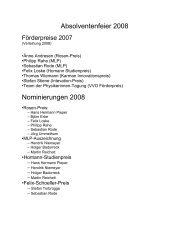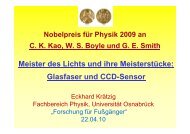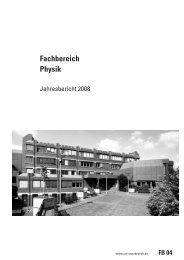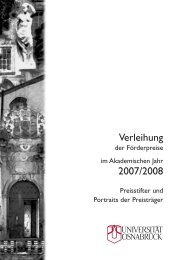Universität Osnabrück, Graduiertenkolleg Mikrostruktur oxidischer
Universität Osnabrück, Graduiertenkolleg Mikrostruktur oxidischer
Universität Osnabrück, Graduiertenkolleg Mikrostruktur oxidischer
Erfolgreiche ePaper selbst erstellen
Machen Sie aus Ihren PDF Publikationen ein blätterbares Flipbook mit unserer einzigartigen Google optimierten e-Paper Software.
GRADUIERTENKOLLEG MIKROSTRUKTUR OXIDISCHER KRISTALLE 11<br />
Zone-center lattice dynamics in LiNbO3 and LiTaO3<br />
Beginn des Projekts: 01.12.1997<br />
Ende des Projekts: 30.11.2000<br />
Dipl.-Phys. Vasile Caciuc<br />
Betreuer: Prof. Dr. G. Borstel<br />
Zusammenfassung<br />
In the framework of the density functional theory, the equilibrium ground-state structure of LiNbO3 in<br />
its both paraelectric and ferroelectric phases is fully optimized using the full-potential linearized plane wave<br />
method. The exchange-correlation energy functional is evaluated within the local density approximation. With<br />
this option the unit cell, c/a ratio and all internal geometry parameters are found to be in good agreement with<br />
the experimental ones.<br />
The Γ-TO phonon frequencies calculated with the frozen phonon method are in good agreement with<br />
the data available for the A1, A2 and E modes in nearly stoichiometric samples. It was shown that the anharmonic<br />
effects play an important role for the softest and the hardest of the A1 modes. The phonon frequencies are<br />
predicted for the Raman and infrared silent A2 modes. The theoretical analysis of the experimentally measured E<br />
modes is performed on the basis of their different behaviour with respect to the 6 Li isotope shift. In addition, the<br />
displacement patterns of all Γ-TO modes are available from the calculated eigenvectors.<br />
The zone-center TO phonons in LiTaO3 were also analyzed within the frozen-phonon approach. The<br />
experimentally observed shift of the TO3 frequency to the higer values compared to LiNbO3 is explained by a<br />
substantial contribution of Li movement in the corresponding eigenvector of LiTaO3, while it is absent in<br />
LiNbO3.<br />
Because the properties of LiNbO3 depend significantly on the presence of both intrinsic and extrinsic<br />
defects, the doped LiNbO3 with trivalent ions was intensively studied over the last years. The ground-state properties<br />
for a 40 atom supercell spanned by [-111], [111] and [111] with Fe on Nb site were investigated. Further<br />
calculations based on a charge compensated mechanism for Cr impurities in a 2x2x2 supercell are now in progress.<br />
Stand der Forschung<br />
The ferroelectric material LiNbO3 has been extensively studied over recent several years due to its<br />
various applications in electro-optics and non-liner optics [1]. Particularly, its ferroelectric transition temperature<br />
of 1480 K is among the highest known to date. For the structurely related ferroelectric system LiTaO3, this parato<br />
ferroelectric transition temperature drops down to 950 K. The Raman spectra recorded for the A1 modes also<br />
exhibit an interesting behaviour. Because the atomic mass of Ta is almost twice as those of Nb, one should expect<br />
that the Raman frequencies in LiTaO3 will be shifted to a lower value compared to LiNbO3. This is indeed<br />
experimentally observed, except for the TO3 mode.<br />
The early theoretical descriptions of the ferroelectric phase transition in these compounds were based<br />
on the effective Hamiltonian model proposed by Lines [2,3]. When applied to LiTaO3, for instance, the pattern<br />
of the para- to ferroelectric phase transition was a mixture of displacive and order-disorder characteristics, being<br />
driven by Li ions movements in a triple potential well. A phenomenological temperature-dependent triple potential<br />
well was also used by Bakker et. al [4] in a quantum mechanical calculation to assign a previously observed<br />
resonance at 32 cm -1 [5] in LiTaO3 to the tunneling of the Li ions through the central and the lowest well. Another<br />
description of the ferroelectric phase transition in LiTaO3 was proposed by Birnie [6] in which Li atoms<br />
were modeled as Frenkel defects. In this case, a double potential well describe the displacements of Li ions between<br />
their centrosymmetric positions and the normally vacant octahedral sites.<br />
Using the full-potential linearized augmented plane wave method (FLAPW), Inbar and Cohen [7,8,9]<br />
investigated from first principles the ferroelectric instability in LiNbO3 and LiTaO3. The total-energy calculations<br />
performed for the ferroelectric distortion simulated as a uniformly scaled experimental soft mode coordinate<br />
revealed that the Li displacements are described only by a single anharmonic potential well. Since a deep<br />
double well was found for a coupled displacements of oxygen and lithium atoms, it was concluded that the lowering<br />
of the total energy associated with the para- to ferroelectric phase transition in these materials is mainly<br />
due to the shift (with respect to Nb) and distortion of the oxygen octahedra. Also, the zone-center potential-







